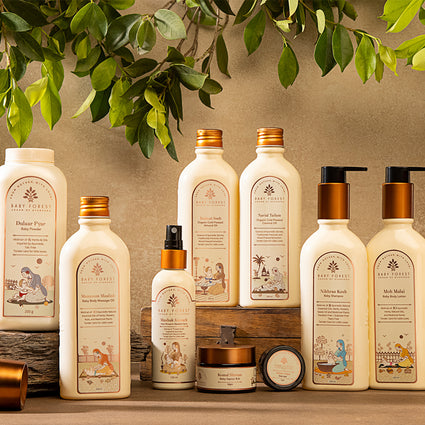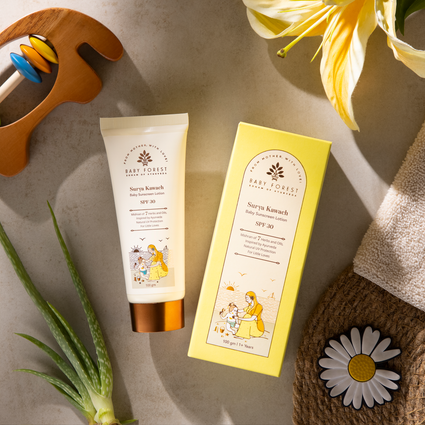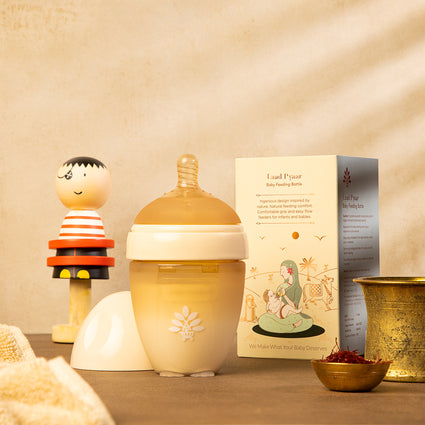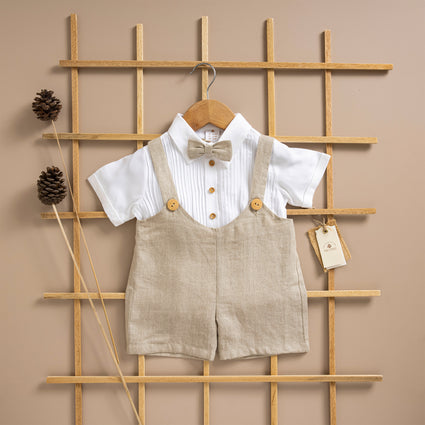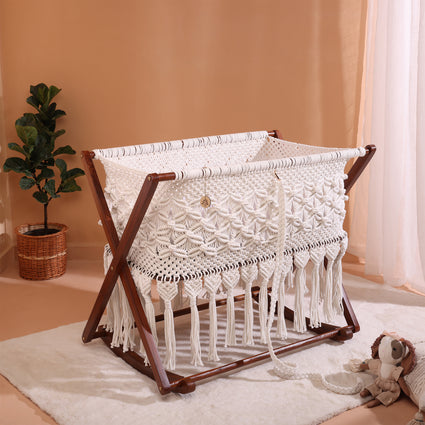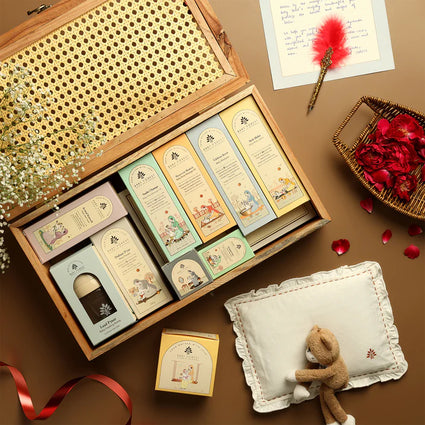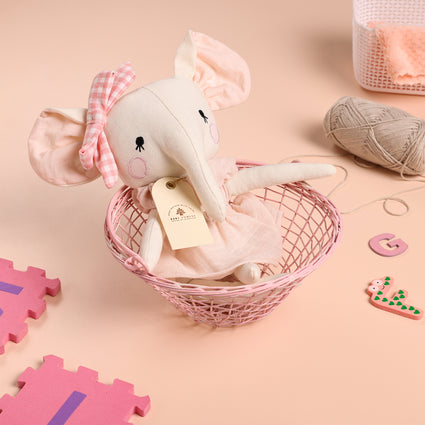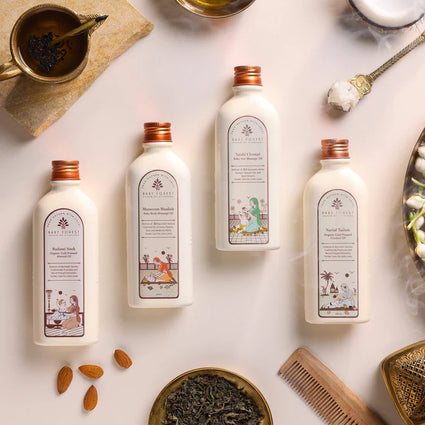Baby Care & Parenting Blogs
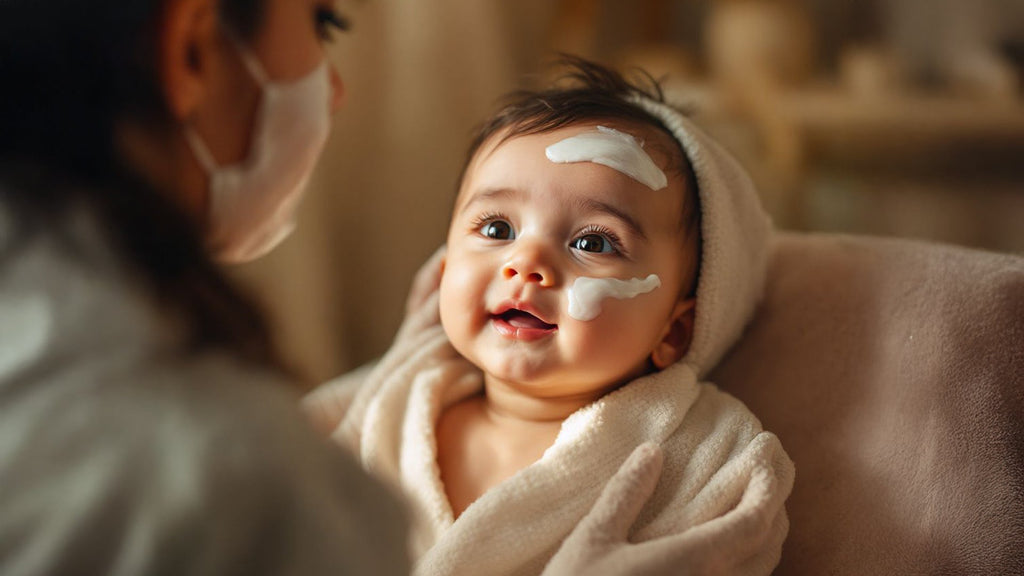
Does Your Baby Need Face Cream? Here's What You Should Know
As a new parent, it's totally normal to wonder about the best ways to care for your baby's delicate skin. You've probably seen a ton of products out there marketed as essentials, but when it comes to baby face cream, is it really necessary? Should you be adding it to your baby care routine? Let's break it down and help you make an informed decision.
Understanding Your Baby's Skin
Babies are born with soft, smooth, sensitive, and still-developing skin. Unlike adults, their skin is thinner, more porous, and more prone to irritation. Plus, it cannot protect itself from environmental stressors like the sun, wind, or pollution. That's why many parents turn to baby face cream that can help shield and hydrate their little one's skin.
However, while their skin might need some extra care, not all products are the right fit. So, let's take a closer look at whether a baby face cream is necessary for your baby.
Does Your Baby Need Face Cream?
In most cases, your baby's skin might not need baby face cream. Newborns and infants usually don't require a complicated skincare routine-just a gentle bath and a mild moisturizer, like baby lotion, will do the trick. Their skin typically does a great job if it's not exposed to harsh conditions.
That said, baby face creams aren't a bad idea either. Sometimes, your little one's skin might need a little extra TLC. If they have dry patches, redness, or irritation, a baby face cream could be just what they need to feel more comfortable. But don't jump to conclusions just yet-let's dive into how you can figure out if your baby really needs one.
Signs Your Baby May Need a Face Cream
There are a few tell-tale signs that your baby might benefit from baby face cream. Here are some of the most common:
-
Dry Skin:
If your baby's skin is feeling rough or flaky, especially on the face, it may be a sign they need some extra moisture. -
Chapped Skin:
Exposure to wind, cold air, or frequent drooling can cause your baby's skin to become chapped, particularly around the cheeks and chin. -
Eczema:
Babies with eczema or other skin conditions may have inflamed or itchy skin, making a soothing baby face cream an important part of their routine. -
Redness or Irritation:
Sometimes, certain environmental factors or even a diaper rash can cause irritation on the face. A gentle, calming cream could help.
If you notice any of these signs, a baby face cream could be helpful in providing extra hydration and soothing relief. But make sure to consult your pediatrician before trying any new products.
What to Look for in a Baby Face Cream
Choosing the right baby face cream can be tricky with all the options available. To make sure you're picking a safe and effective product, here are some key things to look for:
-
Gentle Ingredients:
Look for creams that are free of harsh chemicals, fragrances, or dyes. Natural and organic ingredients like shea butter, aloe vera, and chamomile is great for soothing sensitive skin. -
Hypoallergenic:
Babies can have sensitive skin that's prone to reactions. Opt for a hypoallergenic cream to reduce the risk of irritation. -
Moisturizing:
Since your baby's skin needs plenty of hydration, choose a baby face cream that has moisturizing ingredients such as glycerin, jojoba oil, or coconut oil. -
Non-Comedogenic:
Some creams can clog pores. For babies, look for creams that are non-comedogenic to avoid breakouts or rashes. -
Derma Safe:
Products that are derma safe are often safer and more reliable for your baby's skin.
By paying attention to these qualities, you can choose a baby face cream that will keep your baby's skin soft and hydrated without risking any adverse reactions.
How to Use Baby Face Cream Safely
If you've decided that a baby face cream is right for your little one, it's essential to apply it safely. Here are some tips to keep in mind:
-
Start with Clean Skin:
Always clean your baby's face before applying any cream. Use a gentle, baby-friendly cleanser to remove dirt or impurities. -
Test First:
Before applying a new product, do a patch test on a small area of skin to check for any allergic reactions. -
Use a Small Amount:
Babies don't need a lot of products. A tiny dab of baby face cream is enough to cover their face. -
Gently Massage:
Apply the cream in gentle circular motions to help it absorb into the skin.
By following these simple steps, you'll ensure that you're using baby face cream safely and effectively.
Benefits of Using a Face Cream for Your Baby
Using a baby face cream can offer a range of benefits for your baby's skin, including:
-
Moisture Retention:
Baby skin is more prone to drying out, especially in harsh weather conditions. A nourishing cream locks in moisture and helps prevent dryness. -
Protection from the Elements:
Whether it's cold air or direct sunlight, a good face cream provides an extra layer of protection against environmental stressors. -
Soothing Relief:
For babies with skin irritations, rashes, or eczema, a baby face cream can help soothe the skin and reduce discomfort.
With the right product, a baby face cream can keep your little one's skin soft, protected, and comfortable all year round.
Conclusion
So, does your baby need baby face cream? It really comes down to your baby's skin and any specific concerns you might have. For a lot of babies, a gentle moisturizer does the job just fine. But if your little one has dry patches, redness, or other skin issues, a baby face cream could be exactly what they need. Just make sure to pick one with safe, gentle ingredients, and always check with your pediatrician if you're unsure. At the end of the day, you're doing your best to keep your baby happy, healthy, and comfortable!

Winter Dry Skin in Babies: Why Lotion is a Must-Have This...
Winter brings a chill in the air, cosy blankets, and festive cheers. But for babies, it also brings dry, flaky skin that can be uncomfortable and even painful. As parents, you want your baby to feel soft, smooth, and happy in their delicate skin. That's where baby lotion comes to the rescue, especially organic ones that nurture and protect without any harsh chemicals.
Ingredients like shea butter, coconut oil, and almond oil work wonders for hydration. For example, the Moh Malai Baby Body Lotion use these natural elements to deeply moisturize and nourish, keeping your baby's skin supple and glowing even in winter. Shea butter locks in moisture, coconut oil softens, and almond oil ensures smoothness-all while being gentle and safe.
With the right baby lotion, winter can be all about cuddles and comfort for your little one!
Why Baby Skin Needs Extra Care in Winter
Baby skin is so much thinner and more delicate than ours, making it prone to losing moisture quickly-especially during winter. Dry air outside and heaters inside can leave their skin feeling parched, sensitive, and even itchy.
In cold weather, natural oils in the skin disappear faster, often leading to redness, irritation, or even eczema. Since babies can't tell us they're uncomfortable, you might notice extra scratching, fussiness, or dry patches. That's why using a gentle, organic baby lotion regularly is a game-changer. It not only locks in moisture but also protects their skin barrier and soothes irritation, keeping your little one comfy and happy all winter long!
Benefits of Using Lotion for Winter Dry Skin
Using baby lotion in winter isn't just about adding a soft touch; it's about protecting your baby's health. Here are some benefits:
-
Hydration:
A good baby lotion replenishes lost moisture, keeping the skin soft and supple.
-
Barrier Protection:
Organic lotions often contain natural oils like coconut, almond, or shea butter, which form a protective barrier against harsh elements.
-
Healing Properties:
Many organic baby lotions have ingredients like aloe vera or calendula, which soothe redness and heal minor irritations.
-
Prevents Cracking:
Consistent use prevents severe dryness that can lead to painful cracks or bleeding.
-
Comfort:
Babies with well-moisturized skin are less likely to scratch and fidget, leading to better sleep and happier moods.
Choosing the Right Baby Lotion for Winter
Not all lotions are created equal. When choosing a baby lotion for winter, here are a few things to keep in mind:
-
Go Organic:
Organic baby lotion is free from harmful chemicals, synthetic fragrances, and dyes. It's gentle and safe for sensitive baby skin. -
Look for Moisturizing Ingredients:
Natural ingredients like shea butter, cocoa butter, and almond oil are excellent for deep hydration. -
Hypoallergenic Options:
If your baby has sensitive skin, choose a lotion labelled hypoallergenic to reduce the risk of irritation. -
Fragrance-Free or Mildly Scented:
Strong fragrances can irritate delicate skin. Opt for unscented or naturally scented products. -
Test First:
Always do a patch test on a small area of your baby's skin to ensure there's no allergic reaction.
Tips for Applying Lotion Effectively
Applying baby lotion isn't just about slathering it on. There's a technique to make it work better:
-
Apply After Bath Time:
Moisturize your baby immediately after a bath while their skin is still damp. This helps lock in the moisture. -
Use Gentle Motions:
Use light, circular motions to apply the lotion. Avoid rough rubbing. -
Don't Forget the Creases:
Pay attention to areas like behind the knees, elbows, and neck folds where dryness often hides. -
Keep It Handy:
Reapply throughout the day, especially on exposed areas like the face and hands. -
Warm the Lotion:
Rub the lotion between your palms before applying it to avoid shocking your baby with cold cream.
Additional Winter Skin Care Tips for Babies
While baby lotion is the hero of winter skin care, a holistic approach works best. Here are some additional tips:
-
Humidifier:
Place a humidifier in your baby's room to add moisture to the air. -
Avoid Over-Bathing:
Frequent baths can strip natural oils. Limit baths to every other day and use lukewarm water. -
Dress Wisely:
Use soft, breathable fabrics like cotton to prevent irritation. Avoid wool directly on the skin. -
Stay Hydrated:
If your baby is old enough, ensure they're drinking enough water to keep their skin hydrated from the inside out. - Protect Against the Elements:
Use a weather-appropriate barrier cream or lotion before taking your baby outdoors.
Common Questions Parents Have About Winter Skin Care
-
How often should I apply lotion to my baby in winter?
Aim to apply baby lotion at least twice daily-right after baths to lock in moisture and before bedtime for overnight hydration. If you notice dry patches, feel free to reapply as needed during the day.
-
Can I use regular lotion instead of baby lotion?
It's best not to. Regular lotions often have harsher ingredients that might irritate your baby's sensitive skin. Stick to gentle, specially formulated baby lotions to keep their skin safe and soft.
-
What if my baby's skin is still dry despite using lotion?
If your little one's skin stays dry, it's worth checking in with your paediatrician. They may suggest a richer cream or evaluate for conditions like eczema that might need extra care.
-
Are organic lotions better?
Yes! Organic baby lotions are free from harmful chemicals, making them a safer option. Plus, the natural ingredients deeply nourish and protect your baby's delicate skin.
Conclusion
Winter can be tough, but with a little extra love and the right care, your baby's skin can stay soft, smooth, and healthy. This season, organic baby lotion is a must-have-it keeps your little one's skin hydrated, protected, and comfy no matter how chilly it gets. Pair it with simple skincare habits like short baths and a cosy humidifier, and you'll be mastering winter parenting in no time. After all, happy, healthy skin means a happy baby-and isn't that the best gift of all?
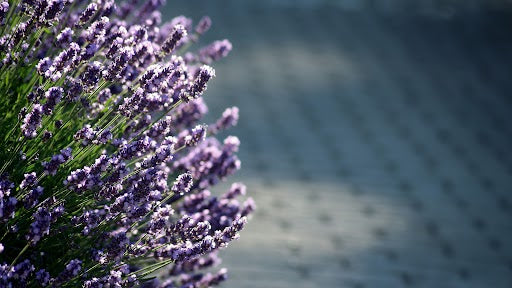
Exploring the Benefits of Lavender Oil for Babies
Lavender, known for its pale color and fragrance, is more than just a beautiful flower. Its oil is used in natural remedies and wellness products. But did you know it also can be used in baby care products? Lavender oil has antibacterial and therapeutic properties that can benefit your baby’s body and mind. Ayurvedic practitioners have been using lavender oil for quite a long time now.
Let's explore how lavender oil can support your baby’s well-being.
Origin of Lavender Oil
The Lavender plant is a member of the mint family. Originally harvested, lavender was later cultivated. It is used in herbal medicine. The name lavender derives from the Latin root “lavare,” which means “to wash.” Lavender oil is extracted from fresh flowers of the lavender plant through a process called distillation. In many regions, lavender flowers are believed to have the power to calm and purify the body and mind.
Benefits of lavender oil in Baby Care

Lavender oil, when used properly can benefit your baby in several ways:
Calming and Soothing Properties
As winters can be harsh on your baby, they might develop nasal congestion. Which can make them really uncomfortable and it is difficult to see them like this. Baby Vapour Rub containing lavender oil can be a gentle and effective way to help relieve this discomfort.
Provide Relief from Colic
Massage can be a great bonding time for you and your baby. Use lavender-infused body massage oil to give your baby a soft massage. This will help in releasing the trapped gas from your baby’s tummy and provide relief from problems like colic and more.
Natural Antibacterial Properties
Lavender oil has a calming fragrance that everyone likes. It also has antibacterial properties making it a natural ingredient in baby- safe floor cleaner, ensuring a clean and calming environment for your baby.
Acts as a Natural Barrier
Lavender oil for babies can help maintain the skin barrier by preventing moisture loss and supporting the natural defenses. Lavender oil-infused mosquito repellents can keep them at bay while being gentle on your baby's soft skin.
Mood-Boosting Properties
Lavender’s mood-boosting properties are largely due to its ability to reduce tension and anxiety. Babies can sometimes feel overstimulated or anxious due to new experiences, and lavender’s gentle aroma can soothe babies, helping them to feel more secure and reduce fussiness.
How to Use Lavender-Based Baby Products
Although Lavender has so many benefits, you must follow safe usage practices while incorporating lavender oil into your baby’s daily routine.
-
Choose Baby-Specific Products
Always select products that are formulated specifically for babies, as they are made with specific guidelines making them an ideal choice. -
Perform a Patch Test
It is recommended to do a patch test before applying any product to your baby's skin. A product with a higher concentration can cause redness, itching, or irritation. Perform a patch test on a small area of the baby's skin to check for any reaction. -
Follow Instructions
Read product labels carefully and use them as directed. Avoid applying the product near the baby’s eyes or mouth. -
Consult your pediatrician
Before using any new product for your baby always consult your pediatrician. As they can provide you with the best guidelines.

Conclusion
Lavender oil, when used thoughtfully, brings a natural and calming touch to your baby's daily care routine. By choosing the right products and following safe usage practices, you can help provide comfort, peace, and well-being for your little one.
Remember that simplicity, safety, and care will always lead to the most gentle and nurturing experiences for your baby.
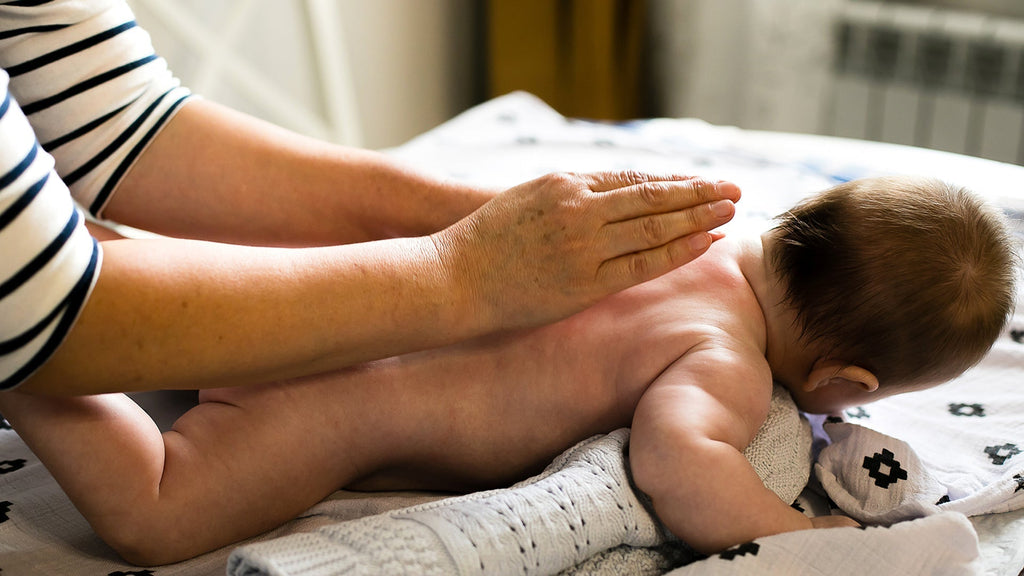
How to Create a Simple Baby Skincare Routine this Winter
Winter can give your baby’s delicate skin a hard time. The cold weather, low humidity, and indoor heating can easily dry out their skin, leaving it rough, irritating, and uncomfortable. Just like adults, babies need a little extra care during this season to keep their skin soft, hydrated, and healthy. Creating a simple baby skincare routine in winter isn’t difficult, but it requires the right products and consistency.
Effective baby skincare step-by-step guide

Step 1: Gentle Baby Massage Oil
A warm oil massage is a fantastic way to start your baby’s day, especially in the winter. Massaging your baby helps improve circulation and keeps their skin moisturized. Choose a natural massage oil that is rich in nutrients and can deeply nourish your baby’s skin.
Look for oils like coconut oil, or almond oil, which are perfect for retaining moisture and protecting against the dryness that winter can bring. Gently warm the oil by rubbing it between your hands and give your baby a relaxing massage for 10-15 minutes before bath time. This also preps the skin for cleansing while ensuring it stays moisturized.
Step 2: Mild Baby Shampoo
During winter, your baby’s scalp can also become dry, and using the right baby shampoo is important to prevent irritation or flakiness. Go for a mild, tear-free shampoo made specifically for babies that don’t strip away natural oils.
Shampoo your baby’s hair gently using lukewarm water, massaging the scalp with your fingertips. Don’t shampoo too often; 2-3 times a week is usually sufficient in winter. This will help maintain the natural oils in your baby’s scalp, keeping it healthy and moisturized.
Step 3: Baby Body Wash
While giving your baby a bath, it is essential to choose a baby body wash that hydrates the skin rather than drying it out. Look for products that are free from harsh chemicals and contain natural, moisturizing ingredients like aloe vera or oat extracts.
Make sure the water is warm, not hot, as hot water can dry out your baby’s skin further. Use the body wash to gently cleanse your baby’s body, focusing on the folds of their skin where moisture loss can be more intense. A quick bath is all your baby needs in winter to avoid stripping their skin of essential oils.
Step 4: Kids Face Wash
Babies often drool or rub their faces, and in winter, this can make their delicate skin even more prone to dryness. A mild kids' face wash is a great addition to your winter skincare routine, ensuring that your baby’s face is clean without being stripped of moisture.
A gentle face wash formulated specifically for children helps remove dirt and impurities, leaving your baby’s face soft and smooth. Make sure you wash your baby’s face with lukewarm water and pat it dry with a soft towel.
Step 5: Rose Water Mist
After cleansing your baby’s skin, especially their face, applying a light mist of rose water can provide extra hydration and soothe any irritation. Rose water is known for its calming properties and helps to lock in moisture, making it a great option to include in a winter skincare routine.
Spritz a bit of rose water mist on your baby’s face and gently pat it in. This step can be particularly helpful if your baby’s skin is sensitive or prone to redness during the colder months.
Step 6: Baby Face Cream
In winter, your baby’s face is often more exposed to the cold air, making it essential to apply a baby face cream that offers deep hydration. Choose a cream that contains natural ingredients like shea butter or almond oil, which provide long-lasting moisture and protect the skin from dryness.
Apply a small amount of face cream after using the rose water mist. Gently massage it into your baby’s face, focusing on areas that tend to get dry, like the cheeks, chin, and forehead. This will help prevent chapped or flaky skin, keeping your baby’s face soft and smooth all day long.
Step 7: Baby Body Lotion
Once your baby’s bath is done, the next important step is locking in all the moisture with a nourishing baby body lotion. Winter can rob your baby’s skin of its natural moisture, so it’s crucial to use a lotion that hydrates deeply and lasts throughout the day.
Look for lotions with ingredients like cocoa butter, shea butter, or aloe vera, which are known for their moisturizing properties. After gently patting your baby dry with a soft towel, apply the lotion all over their body, paying extra attention to areas prone to dryness, such as the elbows, knees, and feet. This will ensure that your baby’s skin stays hydrated and soft throughout the day.
Conclusion
Winter can be tough on your baby’s skin, but with a thoughtful routine and the right products, you can easily protect and nourish it. By keeping their skincare simple and effective, you’re ensuring that their skin stays soft, healthy, and happy, no matter how cold it gets outside.

Here Are The Best Ways to Treat Diaper Rashes: Home Remedies
Is your baby fussy and uncomfortable because of those itchy diaper rashes? Moms are always extra careful with their baby's sensitive skin, but even the best diapers might not always prevent rashes. Almost every baby experiences diaper rashes during their first year. The good news is that with the right care and products, you can treat and prevent diaper rashes effectively.
Is It Diaper Rash or a Yeast Infection?
It's important to know whether your baby has a simple diaper rash or a more serious yeast infection, as both require different treatments. So, how do you tell the difference?
- Diaper Rash: If the rash is slightly red, dry, and not oozy or painful, it's most likely a diaper rash. With the right diaper rash treatment, it should clear up in just a couple of days.
- Yeast Infection: If the patches are located in the folds of the skin or groin area and are oozy, bumpy, or bleeding, it might be a yeast infection. In severe cases, your baby may also develop a fever. A yeast infection can take a few weeks to clear and may need prescription medicines.
Understanding this distinction is key to giving your baby the right care, whether it's home remedies or a prescribed solution.
What Causes Diaper Rashes?
There are several common causes of diaper rashes. Understanding these can help you take the right preventive steps.

Skin Reactions
Babies have extremely sensitive skin, and products like detergents, soaps, creams, and even diapers can cause reactions. Many of these products contain chemicals like boric acid, benzocaine, and salicylates, which are harmful to babies and can lead to diaper rashes.
Solution: Always opt for natural, chemical-free products. For instance, Baby Forest's Mridul Poshaak Liquid Detergent, Nirmalya Snan Natural Baby Soap, and Sampoorna Snan Baby Body Wash are gentle on your baby's skin and help prevent irritation.
Dryness
Babies' skin is more prone to dryness, especially with the frequent use of diapers and wipes. Dry skin can become inflamed, leading to severe rashes if not treated properly.
Solution: Keep your baby's skin hydrated by regularly applying a gentle moisturizer, such as Baby Forest's Moh Malai Baby Body Lotion. It helps lock in moisture and keeps their skin soft and smooth.
Antibiotic and Citrus Intake
If your baby is taking antibiotics, either directly or through breast milk, it can upset the balance of good bacteria and lead to diaper rashes. Similarly, citrus fruits or acidic foods like tomato sauce can irritate the skin, especially around the diaper area.
Solution: Avoid giving your baby citrus foods until their skin has healed, and if they're on antibiotics, monitor for any signs of rashes.
Friction and Infection
Tight diapers that rub against the skin can cause irritation, leading to diaper rashes. It's important to ensure the diaper fits properly, leaving enough room for air to circulate.
Solution: Make sure the diaper is spacious enough to allow you to fit your hand between the diaper and your baby's belly. This helps reduce friction and allows the skin to breathe.
Home Remedies for Diaper Rash
While there are many creams and products available, some simple home remedies for diaper rash can also be effective. Here are a few you can try:
- Coconut Oil: It acts as a natural moisturizer and has antibacterial properties, which can help soothe irritated skin.
- Aloe Vera Gel: Applying aloe vera gel to the affected area can relieve itching and promote healing.
- Breast Milk: Some mothers find that applying a little breast milk to the rash can help soothe it due to its natural antibodies.
Remember, if the rash doesn't improve after a few days of trying home remedies, consult your doctor.
Which Cream Is Best for Diaper Rashes?
There are countless creams available, but the best diaper rash cream should heal the skin naturally and protect it from further irritation. Baby Forest's Komal Kawach Rash Healing Cream is an Ayurvedic solution that's ideal for treating red, itchy rashes.
Infused with natural coolants like vetiver and moisturizing ingredients such as aloe vera and vitamin E, it forms a protective shield on the skin, preventing infection. For parents seeking a more natural alternative, this rash healing cream is a great choice.
Final Thoughts
Diaper rashes are common, but with the right diaper rash solution, your baby can be comfortable and rash-free. Whether you're opting for natural remedies, choosing the best diaper rash cream, or being cautious with the products that touch your baby's skin, the goal is the same: to keep your baby happy, healthy, and comfortable.
By understanding the causes and knowing the right treatments, you can help your baby avoid the discomfort of diaper rashes and enjoy the benefits of smooth, healthy skin.
Reference Link: Helpful Tips for Diaper Rash: What You Need to Know
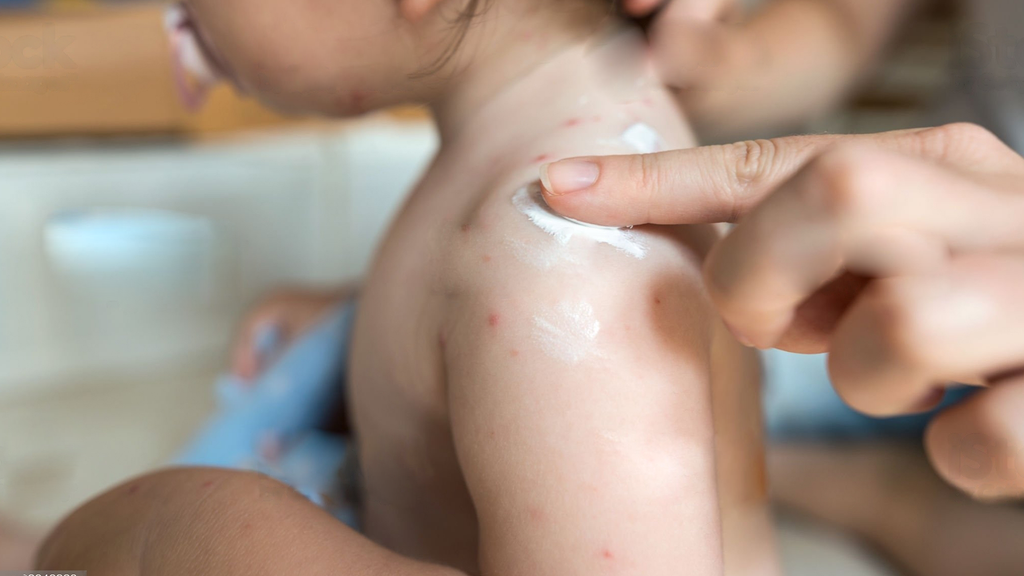
Common Skin Conditions in Babies: An Expert Guide for Par...
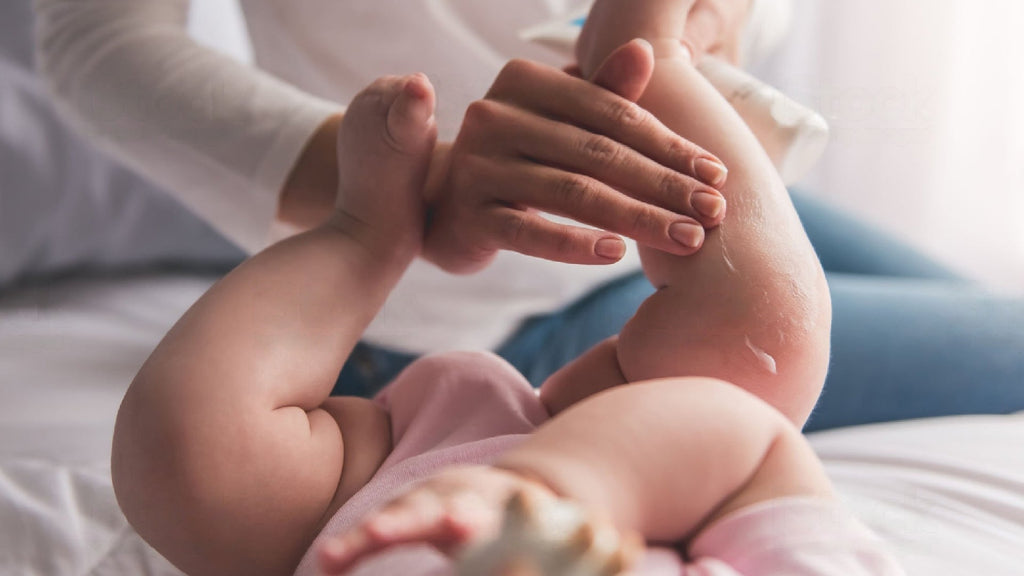
Tips to Choose the Best Baby Lotion For Your Newborn
Baby grooming products must be chosen with the utmost care since a baby’s skin is extremely delicate and soft. But choosing the best skincare for babies is crucial when there are so many options with the number of claims. What would be the proper process to pick the best for your baby?
A lot of baby products with decent fragrances sometimes contain paraben, alcohol, artificial fragrance, etc., which can be harmful to a baby’s sensitive skin.
Among various essential baby skin care products such as shampoo, hair oil, massage oil, etc., let’s explore choosing the best body lotion for babies. Body lotion helps moisturize a child's skin and preserve its natural moisture. Thus, it is crucial to pick body lotion for infants thoughtfully.
How to Choose the Best Body Lotion for Your Baby?
Everyone has a different skin type and texture. Likewise, a baby’s skin is also different. Their pH level is different from adults, as is their skin, which is also more sensitive. Since babies’ skin is very delicate, they tend to have dry skin or may face the problem of eczema.
If you are unaware of your baby’s skin type, you might want to look for a body lotion that is hydrating and treats sensitive skin like a charm. Baby Forest has the ideal body lotion, which could be used on dry, sensitive skin or conditions like eczema, psoriasis, and rashes.
Best Body Lotion For Baby’s Dry Skin
If your baby has dry skin, flakiness, redness, and itchiness are the signs to look for. It is best recommended to get body lotions that are hydrating in nature. Always pay attention to the product composition. Ingredients like Shea Butter and Coconut Oil are known to hydrate the skin thoroughly & naturally lock the moisture. Hence, baby lotions with natural ingredients are highly recommended for your baby’s dry skin as they are not harsh on the skin.
Best Body Lotion For Baby’s Sensitive Skin
If your baby has sensitive skin, avoid choosing a body lotion with artificial fragrances, parabens, and chemicals. Products with these substances tend to irritate sensitive skin more than they do any good. Hence, it is recommended to choose baby lotions with 100% natural ingredients and no artificial fragrance.
Check the Product Labeling
While choosing a body lotion for your little one, ensure the product you pick is dermatologically tested. Checking the product label can help determine the purity of that product. Moreover, it is recommended to avoid thick body lotions as they take more time to absorb into the skin. Since babies’ skin is sensitive, this might irritate them. Hence, choosing a body lotion that is lightweight in texture can work wonders on your baby’s skin.
Choose Organic & Natural Body Lotion
Nothing works better than employing natural remedies to maintain the body's natural heat. Since a baby’s skin is sensitive, using organic and natural body lotions is helpful.
You can check out Baby Forest, which provides the purity of nature blended with the wisdom of Ayurveda for your baby’s delicate skin. Head to our website to check out the best Baby Forest's Moh Malai Baby Body Lotion for your little one and keep those sweet cheeks giggling all the time.
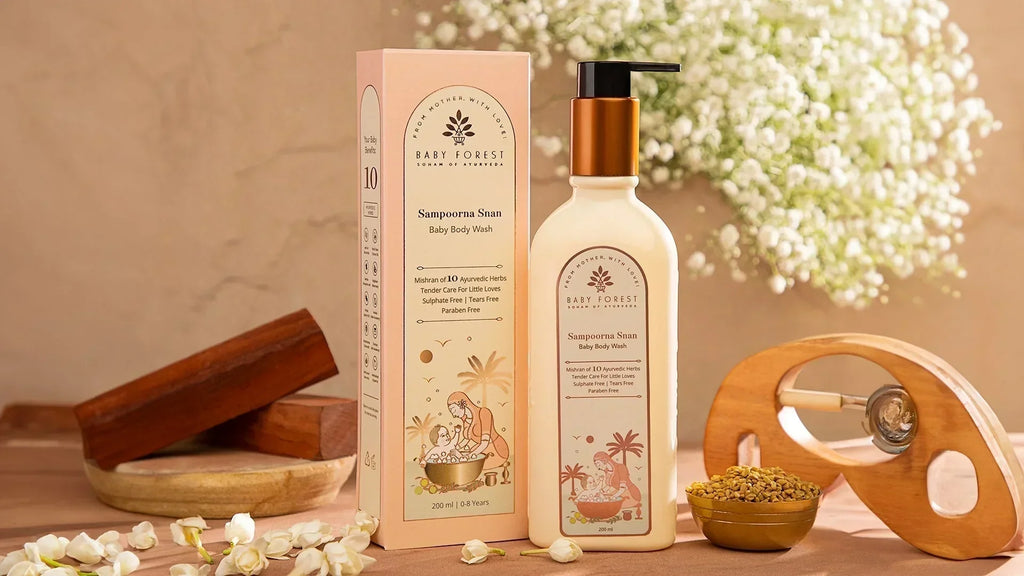
Which Baby Body Wash Is Right for Your Little One?
Body washes are a convenient and soothing way to cleanse your baby's delicate skin. Unlike traditional soaps, which can be drying, and harsh, organic body washes are formulated to be mild and moisturizing, making them a great choice for daily use. Choosing the right baby body wash is crucial because their skin is much more sensitive than adult skin. With countless options available, it can be overwhelming for new parents to find one that is safe, gentle, and nourishing. To simplify your decision, let's delve into the benefits of various natural ingredients found in baby body washes that are effective and gentle. Additional Tips for Bathing Your Baby e on your little one's tender skin.
Understanding Baby Skin
Baby skin is thinner and more susceptible to dryness and irritation compared to adult skin. This is why it's important to choose products specifically designed for babies — products that moisturize and protect without using harsh chemicals. A baby body wash with natural, soothing ingredients can help maintain the natural softness and health of your baby's skin.
Key Natural Ingredients to Look for in Baby Body Washes
When selecting a baby body wash, look for these natural ingredients known for their skin-friendly properties:
-
Jaee Giri (Oat Kernel)
Known for its soothing properties, oat kernel is excellent for baby's sensitive skin. It helps to calm irritation and is incredibly moisturizing, making it perfect for keeping your baby's skin soft and well-hydrated. -
Narial Tailam (Coconut Oil)
Coconut oil is a wonderful moisturizer and is known for its antibacterial and antifungal properties. It's gentle enough for daily use on baby's skin and helps in treating and preventing diaper rash. -
Methika (Fenugreek Leaf)
Fenugreek has natural anti-inflammatory properties that can soothe a baby's skin. It is beneficial for combating cradle cap and eczema. -
Watermelon
Rich in vitamins and water content, watermelon is a hydrating ingredient that keeps the baby's skin fresh and radiant. -
Parijata (Jasmine Oil)
Known for its calming and soothing effects, jasmine oil can help in relaxing your baby, making bath time a more pleasant experience. -
Amalaka (Indian Gooseberry)
A powerhouse of antioxidants, Indian gooseberry helps protect the skin from environmental damage and promotes healthier skin. -
Karpurapuspa (Chamomile)
Chamomile is another ingredient renowned for its soothing properties. It's especially good for babies with irritated or inflamed skin due to its anti-inflammatory benefits. -
Chandana (Red Sandalwood)
Often used in Ayurveda, red sandalwood can help cool and soothe the skin, making it ideal for use in baby body washes. -
Ghrit Kumari (Aloe Vera)
Aloe vera is hydrating and soothing and works well to treat and prevent dry skin patches and diaper rashes. -
Madhukarkati (Grapefruit)
Known for its refreshing scent and cleansing properties, grapefruit is a natural astringent which helps keep your baby's skin clean and refreshed.
Buying the Right Baby Body Wash
When choosing a baby body wash, always opt for products free from parabens, sulfates, and artificial fragrances, which can irritate delicate skin. Look for tear-free products that are derma-safe. Reading product labels and choosing washes that list natural ingredients can help ensure that the product is gentle and safe for your baby.
Additional Tips for Bathing Your Baby
- Before bathing your baby, always remember to test the water temperature.
- Use a soft washcloth to gently apply the body wash.
- Keep bath time short, especially if your baby has very dry or sensitive skin, to avoid further drying out the skin.
- After bathing, gently pat your baby's skin dry with a soft towel and apply a mild moisturizer to retain moisture.
Choosing the right body wash for your baby is about finding a balance between gentle, effective cleansing and skin nourishment. With the right natural ingredients, you can ensure that your baby's skin remains healthy, hydrated, and happy. Remember, every baby is different, so what works for one may not work for another. Don't hesitate to consult with a pediatrician if you have concerns about choosing skincare products for your baby.
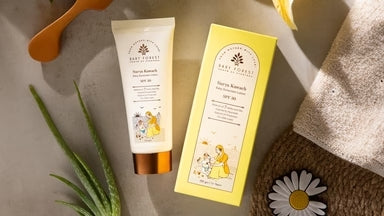
Here’s everything you need to know about Sun Protection F...
Babies are the happiness factor in a family when it comes to the family HQ (Family Happiness Quotient). With Summer at its peak, all parents must make sure that their baby must be sun protective at all times of the day. With so many options of sunscreens available in the market these days, it becomes a task to choose the best one for your little one. In this article, we get straight to the point and provide you with a well-elaborated overview of sunscreen usage for babies and all-around advantages for one’s health.
"Better a sun-kissed than sunburned!" This proverb has more relevance to baby skincare than anything else. Choosing the right baby sunscreen or sunblock, among other things, is an important step in the direction of security concerning the scorching summer heat & UV rays. Parents should look for more natural ingredients than chemicals when it comes to choosing the right sunscreen for their little ones.
Reading labels & making informed choices should be the goal of every parent before applying anything to their baby’s skin. The key requirement is a thorough understanding of the ingredients in the sunscreen and how they are aligned with the specifications for your baby’s skin. Alongside applying sunscreen, one must also ensure the baby is protected with a physical layer of clothing.
There is a very fine line between protecting the skin and protecting the skin with comfort. Organic cotton clothing ensures that the skin area is aerated to avoid overheating. Studies suggest that when using Sunscreen, one must dress the little ones in breathable clothing.
Understanding the concept of UV rays
The UV rays on earth are majorly of two types UVA & UVB rays. While UVA reaches the earth at about 95%, UVB reaches the rest at 5%. As mentioned, Sunlight is good for the baby, one must make sure that the baby is exposed to the morning sunlight only for a reason (The morning UV rays are UVB(generally good for the skin). UVB rays delay tanning & don’t age skin cells. When it comes to the Sun Protection for babies, there is science involved. At birth, the babies are born with a lesser amount of Melanin in their skin, with development in the next 6 months.
SPF (Sun Protection Factor) ranked on the seal is also a vital element to bear in mind. Babies & kids need SPFs of 15 to 30. Therefore, doctors and dermatologists commonly recommend it. A mild range could have provided ample protection without being too harsh on the baby's skin. Parents need to understand that, SPF is not a factor in being protective from sun rays, rather SPF rating denotes protection from UVB rays. Higher SPF doesn’t mean better protection, rather, is directly proportional to the duration of sun protection. Applying and reapplying sunscreen isn't enough, even SPF can only show its real effectiveness in sun exposure combined with other factors.
Specialists believe that having sunscreen should take at least 15 to 30 minutes before one dives into the sun. This makes sure that the sunscreen is absorbed completely by the skin and that all its protective factors can be utilized completely. The most important thing is reapplication of SPF every 2 hours to stay above that optimal protection where the exposure time is extended by the sun.
But while we talk about the application of sunscreen, it is always recommended to do a patch test on your baby as recommended by the FDA, as their skin is delicate and sensitive & might get affected by any ingredient of the product. As mentioned, higher SPF doesn't necessarily mean better protection against the sun despite the myths around the number. SPF 15 blocks out about 93% of UVB radiation, while SPF 30 offers 97% protection. If you use an SPF rating of 50 and above there is not significant protection increase.
As per reports, it is always recommended to use natural ingredients like Sea Buckthorn, Cocoa Butter, & Daffodil that not only protect the baby’s skin but also hydrate & enrich their skin as well. These elements don't just make the products effective but also help to support the baby`s skin's overall health and well-being at the same time.
In conclusion, the need to apply sunscreen to babies should be stressed tremendously. Sunscreen offers much more than UV protection to the skin of a baby. It guards against sunburn and shields from long-term harm to the skin, making it mother's primary skincare partner. Sustaining the experts' recommendations and acknowledging the parents to be alert will ensure that the infants' delicate skin soaks in the sun's rays under the protective covering on the right note, by no means affecting the little one's skin health.
Related Read - The Importance of Sun Protection: Why Baby Sunscreen is a Must
Related Blog - Top Summer Baby Care Essentials for Your Little One
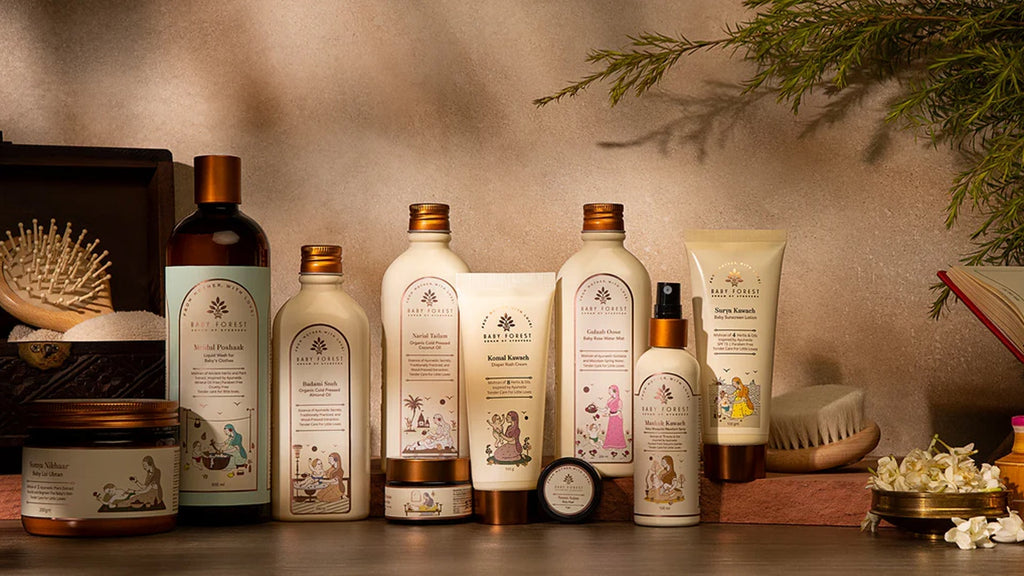
Top Summer Baby Care Essentials for Your Little One
With the changing weather and the temperatures rising, the days grow longer, so ensuring your little one remains comfortable and protected through the summer months becomes a priority. You must take care of your little one, especially during the hot summer days. In this blog, we have curated a list of essential summer baby products and tips to keep your baby happy and healthy during the warm season. From baby skincare to travel essentials, we have a detailed guide designed to cater to your baby's unique needs this summer.

Baby Skincare and Bathing
Summer calls for extra care and attention to skincare and bathing to prevent irritation and keep your baby's skin healthy. The two must-have products are:
Water Baby Wipes

These water wipes are ideal for sensitive skin. They are infused with purified water and free from harsh chemicals, ensuring a gentle cleanse every time.
Rash Healing Cream

With the heat leading to more frequent cases of diaper rash, a reliable cream is essential to soothe and protect your baby's delicate skin.
Baby Sunscreen Lotion

The delicate skin of babies is particularly vulnerable to the harmful rays of the sun. Choose a sunscreen specially formulated for babies, with a high SPF to provide effective protection against UVA and UVB rays. You should apply the baby sunscreen 30 minutes before going out, and reapply frequently to ensure your baby stays protected under the sun.
Keeping your baby cool and comfortable outside is crucial during the hot weather.
Summer Clothing

We opt for warm clothes for winter, and similarly, for summer, it is essential to look at lightweight and breathable fabrics. You can get a crochet baby girl dress or a knotted bodysuit that allows air circulation and keeps your baby cool and stylish.
Baby Rose Water Mist

A refreshing mist can soothe and cool your baby's skin throughout the day. It's perfect for a quick refresh, especially after playtime or when outdoors.
Talc-free Baby Powder

Applying talc-free baby powder after a bath or during diaper changes can help absorb extra moisture and prevent heat rash.
Ensuring your baby is well-hydrated and comfortable is easier with these gentle and effective products.
Baby Body Lotion

After a day out, moisturizing your baby's skin with a baby body lotion helps restore any moisture lost due to exposure to the elements and can help in calming any minor irritations. This routine can help protect your baby's skin from environmental stressors.
Here are some additional tips for summer care to ensure your baby's comfort and safety during the hotter months:
-
Choose the Right Time for Outdoor Activities
Plan outdoor activities during the cooler parts of the day, typically in the early morning or late afternoon. Avoiding the peak sun hours between 10 a.m. and 4 p.m. can help minimize sun exposure. -
Use a Lightweight Stroller with a Sunshade
When taking your baby out for a stroll, use a lightweight and breathable stroller, and make sure it has a sunshade to protect your baby from direct sunlight. -
Dress Weather Appropriate
Dress your baby in loose, lightweight, and light-coloured clothing that covers as much skin as possible. Fabrics like cotton help keeps the skin cool by allowing it to breathe. -
Maintain a Cool Indoor Environment
Use fans, air conditioners, or open windows to create a comfortable and relaxed indoor environment. Consider using a room thermometer to keep track of the temperature, ensuring it's not too hot or too humid. -
Frequent Baths or Cool Washes
Giving your baby a cool bath or gently wiping them down with a damp cloth or baby wipes can help reduce body temperature and soothe irritated skin. -
Monitor Fluid Intake
Ensure your baby is well-hydrated. If they are exclusively breastfed, they might need to nurse more often. If your baby is older and eat solids, offer small amounts of water throughout the day. -
Regularly Clean and Check Baby Gear
Clean all baby gear using a baby-friendly toy and surface cleaner. Including strollers, car seats, and play mats, as heat and humidity can cause bacteria and mold to grow faster than usual.
Summer brings a host of new adventures for you and your baby, but it also calls for a shift in the caregiving routine. You can ensure that your little one enjoys the season safely and comfortably by choosing the right products, such as lightweight cotton clothing, gentle skincare items, and proper sun protection. With this, you can enjoy the sunny days ahead with peace of mind, knowing you're fully equipped to handle the heat!
With these summer essentials, your baby will be well-prepared to face the warm months, and you can enjoy this vibrant season with less stress and more joy.
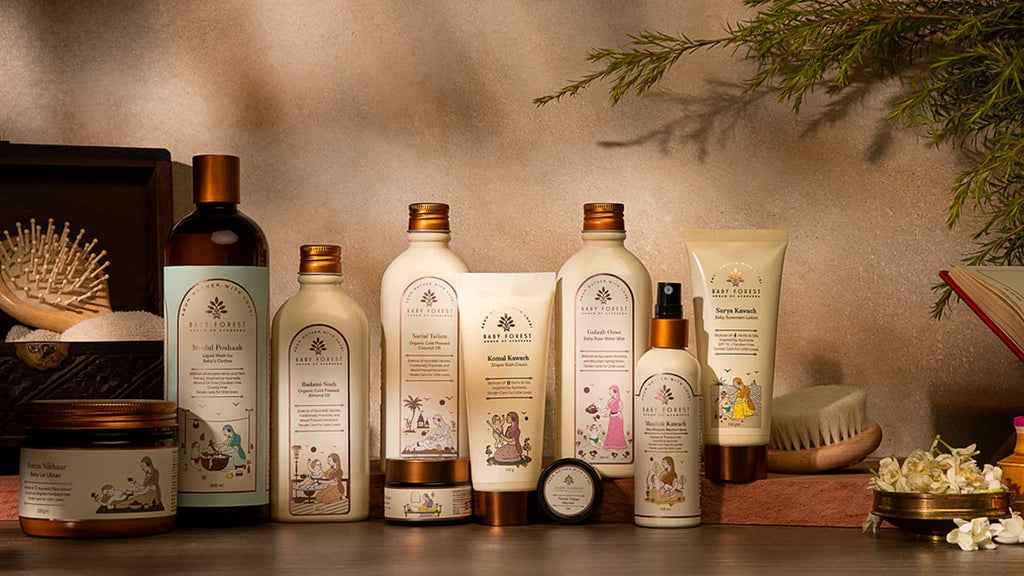
What is the Difference Between Natural Fragrance and Adde...
When it comes to choosing baby products, from lotions and shampoos to baby wipes and creams, parents are faced with a plethora of choices. One aspect that often prompts questions is the difference between natural fragrances and added (or artificial) fragrances in these products. Once you understand these differences, you will be able to make informed decisions for your baby's health and well-being.
What Are Natural Fragrances?
Natural fragrances in products for infants are derived from natural sources, such as plants, flowers, and fruits. These fragrances are obtained through cold pressing, distillation, or extraction. Because they come from natural sources, they often carry the intrinsic benefits of their original plants, such as calming or soothing properties.
Benefits of Natural Fragrances:
-
Gentle on Skin:
For babies with sensitive skin, natural fragrances are less likely to irritate compared to synthetic alternatives. -
Therapeutic Properties:
Some natural fragrances offer therapeutic benefits, like lavender, which is known for its calming effect.
Considerations:
-
Allergies:
Some babies may be allergic to natural ingredients. It's important to monitor for any adverse reactions.
What Are Added (Artificial) Fragrances?
Added or artificial fragrances are chemically created scents designed to mimic natural smells or to create entirely new scents. These fragrances are formulated in labs and can be composed of various chemicals.
Benefits of Added Fragrances:
-
Consistency:
Products with artificial fragrances maintain the same scent over time, providing consistency across batches.
-
Diversity of Scents:
Artificial fragrances can create a wide range of scents that might not be achievable with natural ingredients alone.
Considerations:
-
Skin Sensitivity:
Synthetic fragrances are more likely to irritate sensitive skin, causing reactions such as rashes or redness. -
Health Concerns:
Some studies suggest that certain chemicals in artificial fragrances could have negative health effects over the long term, though more research is needed.
Making the Right Choice for Your Baby
When deciding between baby products with natural or added fragrances, consider the following tips:
-
Know Your Baby's Skin:
If your baby has sensitive skin, opting for fragrance-free or naturally scented products might be the best choice. -
Read Labels Carefully:
Look for products that specify "natural fragrance" or "fragrance-free" if you wish to avoid synthetic scents. -
Patch Test:
Before you use any new product on your baby, do a patch test by applying a small amount on their arm or leg to check for any adverse reactions. -
Consult a Paediatrician:
If in doubt, consulting with your child's paediatrician can provide personalized advice based on your baby's specific health and skin needs.
Whether you choose baby products with natural fragrances, added fragrances, or no fragrances at all depends on your preferences and your baby's skin sensitivity. Being informed and cautious can help ensure that your choices support your baby's health and happiness.
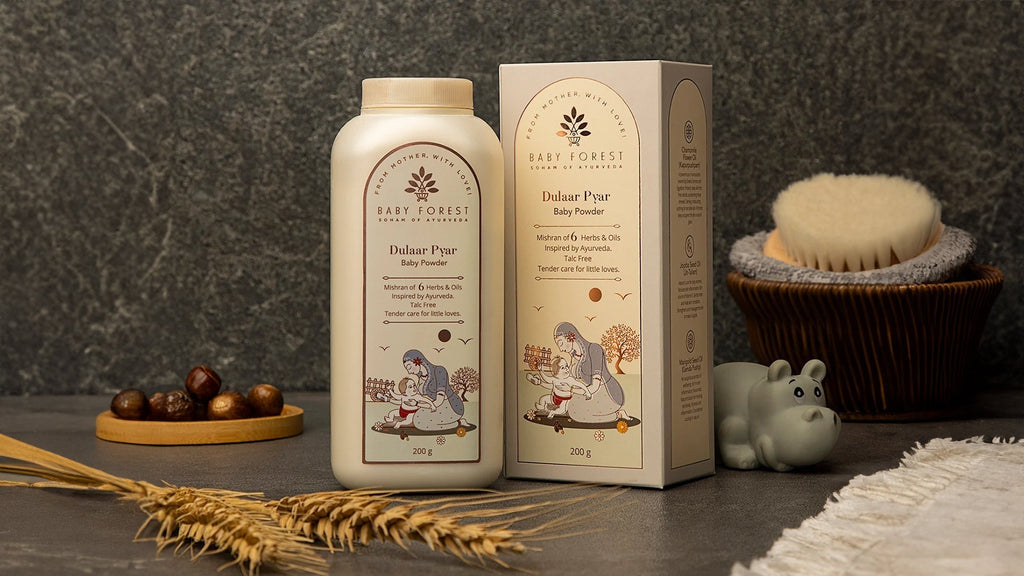
Why Talc-Free Baby Powder is a Must for Summer Heat?
As temperatures soar during the summer months, keeping the little ones comfortable becomes a priority for every parent. An essential item in many households is baby powder, especially to combat the heat and humidity that can cause discomfort and skin rashes in babies. However, the type of baby powder you choose is crucial. In this blog, we'll explore why talc-free baby powder is a safer and healthier choice for your baby during the hot season.
All About Talc and Its Concerns
Traditionally, a lot of baby powders used to have talc in them, which is basically made up of magnesium, silicon, and oxygen. Talc is popular because it's really good at soaking up moisture and reducing friction that causes chaffing , which is why it was often used in baby powders and other beauty products. However, there have been a few concerns about talc's safety over the years. The main issue is its potential contamination with asbestos, a known carcinogen, and the risk of respiratory problems if infants inhale the fine particles.
In light of these concerns, many parents and health experts advocate for the use of talc-free products, particularly for babies who are more vulnerable to the adverse effects of these particles.
What is Talc-free Baby Powders?
Talc-free baby powders are a gentle alternative to traditional baby powders that contain talc, a mineral known for its moisture-absorbing properties. Instead of talc, these powders use natural, plant-based ingredients such as Cornstarch, Chamomile Oil, and Oats Kernel, which are equally effective at keeping moisture at bay without the associated health risks of talc, such as potential contamination with asbestos and respiratory issues from inhalation.
Benefits of Talc-Free Baby Powder
-
Safer Ingredients:
Talc-free baby powders are usually made with cornstarch or other plant-based ingredients like aloe vera. These natural alternatives are gentle on the baby's sensitive skin and are free from asbestos risks. -
Prevents Rash:
During summer, the risk of rashes increases due to the heat and humidity. Talc-free baby powders absorb excess moisture naturally, keeping the baby's skin dry and comfortable, thereby preventing rashes. Additionally you can use Rash Healing cream. -
Avoids Respiratory Risks:
The particles in talc-free powders are generally larger and less likely to be inhaled than those in talc-based powders. This reduces the risk of respiratory problems, which can be serious for children. -
Natural Skin Care:
Many talc-free powders contain additional natural ingredients that benefit the baby's skin. Ingredients like aloe vera and chamomile can help soothe the skin and prevent irritation, making them ideal for use in sensitive diaper areas during the hot months.
Choosing the Right Talc-Free Baby Powder
When selecting a talc-free baby powder, look for products that are:
-
Natural:
Ensures that the product is free from harmful chemicals and genetically modified organisms. -
Artificial Fragrance-Free:
Added fragrances can irritate a baby's delicate skin. Opt for products with no added fragrance to avoid potential allergens. -
Derma Safe:
Choose products that are derma-safe and approved for use on sensitive skin.
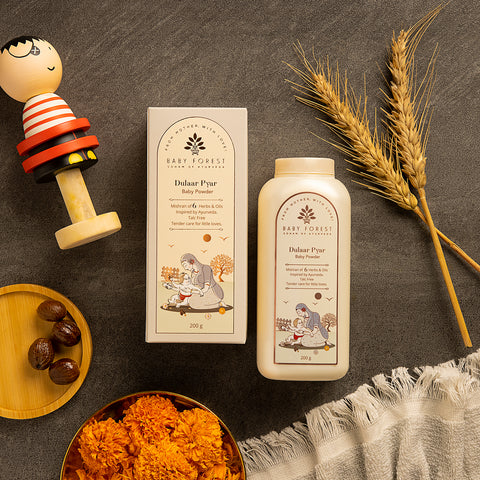
How to Use Talc-Free Baby Powder Safely
To maximize benefits and minimize any risks, even with talc-free powders, it's important to use baby powder correctly:
-
Apply Sparingly:
Use a small amount of powder and keep it away from the baby's face and eyes to avoid inhalation. -
Direct Application:
Apply the powder directly to your hands, away from the baby, and then to the baby's skin. This method helps to control the amount of airborne particles.
Talc-free baby powder is a much safer and healthier option for summer baby care. By incorporating talc-free baby powder into your daily routine, you can ensure that your baby enjoys the summer safely and comfortably. With natural ingredients that are gentle on the skin and effective at moisture absorption, talc-free powders can help keep your baby dry, comfortable, and happy during the hot weather. Always opt for natural, cruelty-free, and derma-safe products to ensure the best care for your little one's delicate skin. Enjoy a worry-free summer with the right products for your baby's needs! Whether at home or on the go, this simple change can make a big difference in your baby's well-being during the warm season.

Benefits of Baby Rose Water for Your Little One
Caring for your baby's skin is as essential as nurturing their health. In a world teeming with baby skin care products, finding the gentlest and most natural option for your little one can be a challenge. Among the myriad choices, baby rose water stands out as a remarkable solution that not only pampers but also benefits your baby's delicate skin.
Crafted from the essence of native rose petals, it brings nature's best to your baby's skincare routine. Here are a few
Benefits of incorporating baby rose water into your daily routine:
-
Soothing Calmness
The core ingredient, Rosa Damascena flower water, is renowned for its calming properties. Native rose petals are carefully selected and distilled to create rose water and it offers a soothing touch to your baby's skin. The natural fragrance of roses is not just a scent but a sensory experience that calms the mind and body. It's like wrapping your baby in a soft, fragrant hug that soothes them into peacefulness. The delicate aroma of roses also ensures your baby enjoys a luxurious, calming bath time, making it a serene ritual.
-
Hydration and Nourishment
Baby rose water is a fantastic hydrator. Due to its vital formulation, enriched with Vitamin E, it aids in preserving the skin's moisture barrier, which helps in avoiding dryness and ensures the skin remains smooth and pliable. This works as a natural moisturizer that absorbs easily without leaving any greasy residue, ensuring your baby's skin remains hydrated and nourished. -
Natural and Safe Ingredients
When choosing rose water for your baby, it's crucial to opt for a product with natural and safe ingredients. A formula comprising Rosa Damascena Flower Water and Vitamin E, without any added chemicals, is ideal. This ensures that the product is gentle on your baby's skin and free from any harmful substances. By selecting a natural, cruelty-free, and derma safe rose water, you provide your baby with the safest and most loving care.
-
Versatility
Its natural soothing properties make it an excellent choice for various situations – from diaper changes to after bath time, ensuring your baby's skin remains clean, calm, and refreshed. On hot and humid days, a quick spritz of rose water can provide an instant refreshment for your baby, helping to cool and soothe their delicate skin. The gentle fragrance of rose water also adds a mild, pleasant scent that can comfort and relax your baby, making it a perfect, all-natural way to enhance their overall well-being and comfort throughout the day.
Pro Tip for Using the Gulaab Oose - Baby Rose Water Mist:
To enhance the nourishment and softness, combine a few drops of the rose water mist with Loi Ubtan Powder and gently massage it into your baby's skin. This blends not only hydrates but also leaves the skin incredibly soft, supple, and with a healthy glow. It's a simple yet effective way to enhance the natural benefits of rose water, providing your baby with the ultimate skincare treatment.
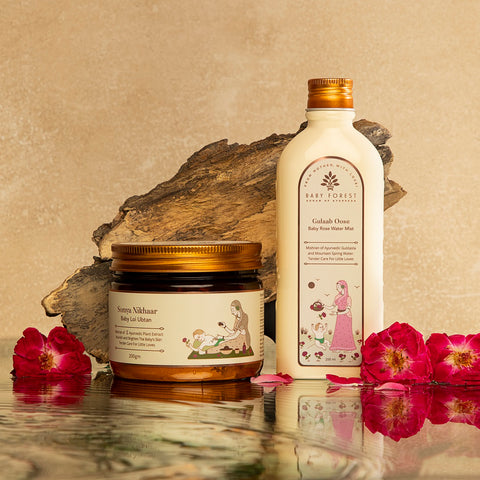
Related Read - Baby Loi Ubtan: Traditional & Modern Care for Stylish Moms
Selecting the appropriate skincare products for your baby is crucial. By choosing a product that is natural, cruelty-free, and free from harsh chemicals, you're guaranteeing that your baby benefits from the finest offerings of nature. Incorporate baby rose water into your baby's skincare routine for a touch of nature's gentleness and purity, embracing its benefits for a happy, healthy baby.
Whether you're a new parent looking for inspiration for the perfect baby shower gift ideas or simply looking for any essential baby care product, like the best baby lotion, our resources are designed to guide you every step of the way.
You can also read more about the traditional and modern significance of using a mustard seed pillow for your little one and explore its various benefits. Or, if you're interested in understanding the richness of Indian ceremonies for your child, our detailed guides on the Annaprashan ceremony and Mundan ceremony will offer insights and practical tips to celebrate these milestones for your little one.
You can read more blogs to ensure that your parenting path is well-informed, joyful, and rich in tradition and care.
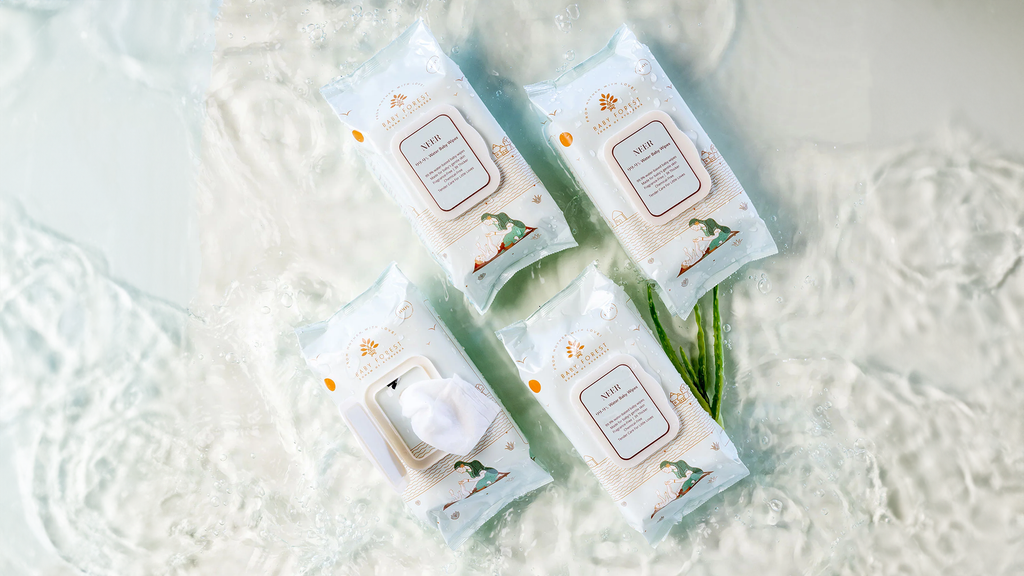
The Benefits of Using Water Wipes for Your Baby's Delicat...
In the life of a new parent, every choice made for their little one holds immense significance, especially when it comes to their comfort and health. One such pivotal decision revolves around selecting the right kind of baby wipes for the baby's delicate skin. There are numerous baby products available online, so it becomes crucial to understand why water wipes stand out as the optimal choice for your infant's hygiene and well-being.
Understanding the Delicate Nature of Your Baby's Skin
The skin of a baby is more sensitive when compared to an adult. It is more prone to irritation and allergic reactions when exposed to harsh chemicals commonly found in traditional baby wipes. This is where water wipes come into play. Infused with purified water and natural ingredients like aloe vera extract, these wipes offer a gentle yet effective solution for cleaning your baby without causing any harm.
The Purity of Water Wipes
Water wipes are designed with your baby's health in mind. They are predominantly made of purified water, typically over 99%, ensuring that the wipes are free from harmful chemicals and irritants. The simplicity of water combined with the natural soothing properties of aloe vera makes these wipes ideal for frequent use, reducing the risk of diaper rash and skin irritations.
Ultra-Soft Bamboo Fabric
The choice of material in baby wipes is as crucial as the ingredients. Ultra-soft bamboo fabric is renowned for its natural properties: it's anti-bacterial, hypoallergenic, and, most importantly, incredibly gentle on your baby's skin. Unlike traditional materials, bamboo fabric is more absorbent, ensuring a cleaner wipe with less rubbing, thus preventing redness or inflammation.
No Added Fragrance
Many baby wipes come with added fragrances, which, while pleasant, can lead to skin irritations or allergic reactions. Water wipes, especially those that are unscented, eliminate this risk, making them safe for even the most sensitive skin. By choosing fragrance-free wipes, parents can avoid unnecessary chemicals and ensure a pure and natural cleaning experience for their babies.
Dermatologically Tested
When selecting baby wipes, look for those that are dermatologically tested and approved. This certification attests to their safety, assuring that they are devoid of alcohol, parabens, and other harsh chemicals that may harm your baby's skin. It gives parents peace of mind, knowing that the wet wipes for babies they use have been tested and proven to be gentle and safe for newborns and babies with sensitive skin.
Free from Harmful Chemicals and Alcohol
The absence of harmful chemicals and alcohol in water wipes further underscores their suitability for newborns. Alcohol, commonly found in various cleaning products, can cause drying and irritation to delicate skin. By choosing water wipes, parents can ensure their baby's skin remains hydrated and protected from potential irritants found in conventional wipes.
Environmental Impact and Sustainability
Using bamboo-based water wipes benefits both your baby's skin and the environment. Bamboo is a sustainable and biodegradable material, making these wipes an eco-friendly alternative to traditional options. By opting for water wipes, parents are making a conscious choice to protect their baby's health and contribute positively to the planet's well-being.
How to Use Baby Forest Neer 99.9% Water Baby Wipes
Using Baby Forest Neer 99.9% Water Baby Wipes is a simple and effective way to keep your baby clean and refreshed, whether at home or on the go. Start by opening the lid located at the top of the pack to access the moisture-rich wipes. Gently pull out a single wipe, ensuring that the rest remains covered. Close the lid firmly after each use to retain the wipes' moisture and prevent them from drying out. Use the wipe to gently clean your baby's skin, including the bottom, face, and hands, effectively removing dirt, germs, and impurities. These wipes are designed for delicate skin, making them suitable for frequent use. Dispose of the wipe responsibly after use, and ensure the pack is sealed to maintain the high quality of the remaining wipes.
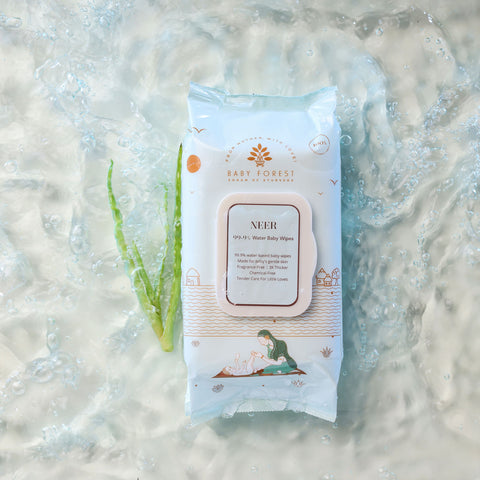
Final Thoughts
The journey of parenthood is full of decisions that shape the health and happiness of your baby. Selecting the right baby wipes is a small yet significant part of this journey. Water wipes, particularly those crafted from ultra-soft bamboo fabric and infused with purified water and aloe vera, offer a safe, gentle, and eco-friendly solution for maintaining your baby's hygiene and comfort.
In embracing water wipes, you are choosing a baby product that aligns with the delicate nature of your baby's skin while supporting sustainable practices. Remember, in the vast sea of choices, the simplest ones are often the best for your baby and the environment.
As you navigate through the early stages of parenthood, let your love and care for your baby guide your decisions. By opting for water wipes, you are ensuring a gentle, pure, and loving touch for your baby's delicate skin, reinforcing your commitment to their health and happiness.
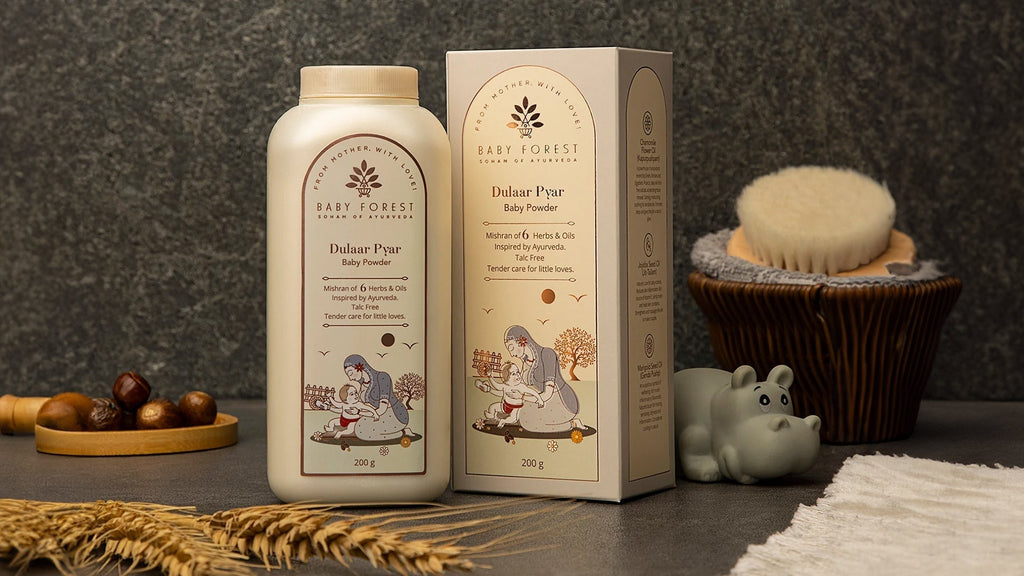
Why Talc-Free Baby Powder Is the Ideal Choice for Infants
When it comes to selecting baby products, parents invariably seek the finest, safest options for their cherished little ones. A significant amount of time is dedicated to meticulously researching and choosing products that promise to be gentle and nurturing for their baby's sensitive skin. Among these products, baby powder has stood as a household staple for generations. Yet, it's crucial for parents to exercise caution, particularly with powders containing talc, as not all baby powders are created equal in terms of safety.
Baby powder, a staple in many households, has come under scrutiny, leading to a shift towards talc-free baby powder. This article delves into why talc-free baby powder is the best choice for your infant, incorporating natural, safe, and gentle ingredients for your peace of mind.
The Shift to Talc-Free
In recent years, the safety of talc-based products has been questioned, prompting parents and manufacturers alike to seek safer alternatives. Talc-free baby powder has emerged as an ideal choice, offering the same benefits without the potential risks associated with talc. But what makes talc-free powder the superior option for infants?
Understanding Talc-Free Baby Powder
Talc-free baby powder is made without talc, a mineral comprised of magnesium, silicon, and oxygen. Instead, it relies on natural and safe alternatives like corn starch, which provides the absorbency and smoothness for which baby powder is known without the associated health concerns.
The Benefits of Going Talc-Free
-
Health and Safety
Talc-free baby powder is gentler on your baby's delicate skin. With no talc as an ingredient, it eliminates the risk of respiratory issues or adverse skin reactions, making it a safer choice for daily use. -
Natural Ingredients
Talc-free baby powders often contain natural ingredients such as chamomile oil, jojoba oil, aloe vera, marigold seed oil, oats kernel, and corn starch. These ingredients not only help in keeping the baby's skin dry but also soothe and nourish it, enhancing the skin's natural barrier. -
Cruelty-Free and Eco-Friendly
Many talc-free baby powders are also cruelty-free, not tested on animals, and are environmentally friendly. This commitment to ethical practices adds an additional layer of appeal for conscientious parents.
Choosing the Best Powder for Your Baby
When selecting a baby powder, looking for talc-free options is just the beginning. The best baby powder for your infant is one that is not only safe but also nourishing for their skin.
-
Chamomile Oil:
It has soothing effects and can help soothe sensitive skin, making it an ideal element in baby powder. -
Corn Starch:
A natural absorbent, corn starch effectively absorbs moisture, keeping your baby's skin dry and comfortable. -
Jojoba Oil:
This oil closely mimics the skin's natural oils, providing moisturization without clogging pores or causing irritation. -
Aloe Vera:
Aloe vera's healing and soothing characteristics make it ideal for treating diaper rash and other skin irritations. -
Marigold Seed Oil:
Known for its anti-inflammatory properties, marigold seed oil can help reduce redness and promote skin healing. -
Oats Kernel:
Oatmeal not only offers comfort but also contains components that can shield the skin and avert irritation.
Tips for Using Talc-Free Baby Powder
-
Apply with Care
To avoid inhalation, sprinkle the powder on your hands away from your baby before applying it to their skin. -
Focus on Moisture-Prone Areas
Apply baby powder to areas that tend to retain moisture, such as the diaper region, underarms, and skin folds. -
Choose Containers Wisely
Opt for powders in shaker bottles or containers that allow for controlled dispensing to minimize airborne particles.
Addressing Common Concerns
With the transition to talc-free baby powders, some parents may wonder about the effectiveness of these natural alternatives. Rest assured, talc-free powders are equally effective in absorbing moisture and preventing diaper rash. The key is in the quality of the formulation and the blend of natural ingredients used.
Choosing talc-free baby powder helps to ensure your infant's safety and comfort. With natural ingredients that soothe, protect, and care for delicate skin, talc-free powders offer parents a worry-free option for keeping their babies dry and comfortable. As you begin on the road of motherhood, choosing products that meet the highest safety and care requirements demonstrates your love for and devotion to your child's well-being. Remember, the best baby powder is one that keeps your baby happy, healthy, and smiling naturally.
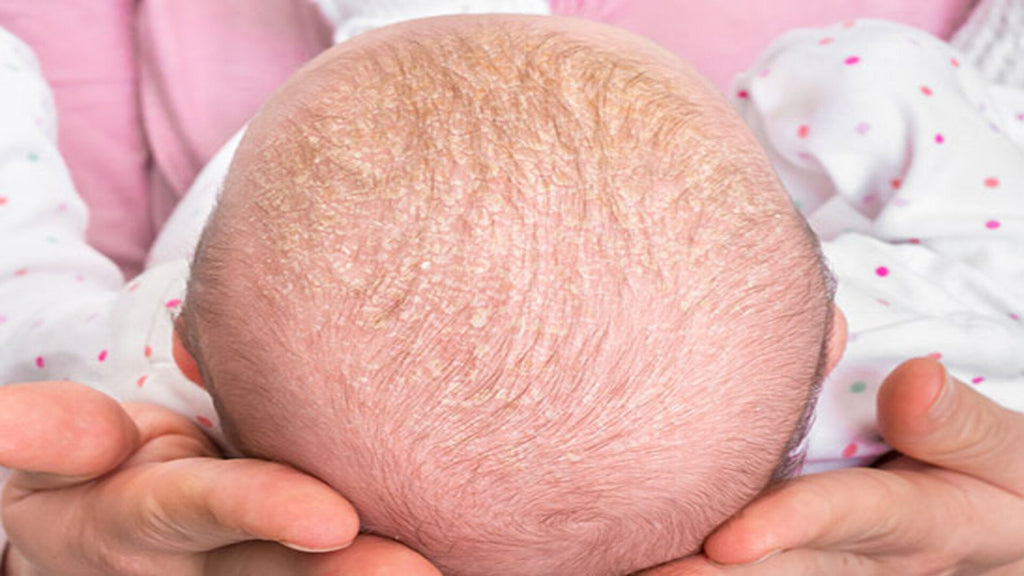
Dealing with Cradle Cap: Causes, Treatment Options, and P...
One common puzzle that many new parents encounter is the cradle cap. This harmless but often perplexing condition can leave tiny scalps looking a bit flaky. In this article, we'll understand cradle cap, its causes, treatment options, and proactive measures parents can take to keep their little one's scalp healthy and happy.
What is a Cradle Cap?
Cradle cap, scientifically termed seborrheic dermatitis, is a prevalent skin condition that commonly manifests in infants within the initial months of their lives. This condition is typically identified by the presence of yellowish, greasy scales on a baby's scalp, making it look like a mild case of dandruff. Though a cradle cap isn't itchy or painful for your baby, it can understandably cause concern for parents.
A cradle cap tends to make its debut in the first few weeks of a baby's life and can persist for a few months. While it might be a bit unsightly, the good news is that the cradle cap in infants is temporary and usually resolves on its own without causing any long-term issues for your little one.
Cradle cap tends to impact approximately 10 per cent of newborns within their first month, with the prevalence soaring to 70 per cent by the time they reach three months old. Surprisingly, the occurrence diminishes significantly to only 7 per cent in infants aged 1 to 2 years.
Causes of Cradle Cap
-
Sebum Overproduction
One of the primary causes of cradle caps is the excess production of sebum, a natural oil that the skin produces. In newborns, the sebaceous glands can go into overdrive, resulting in an excess of this oily substance. When dead skin cells mix with sebum, it results in the characteristic yellowish crust seen in the cradle cap. -
Fungal Involvement
The presence of a fungus known as Malassezia, which resembles yeast, is considered to be another factor that contributes to the problem. While harmless, this fungus can exacerbate the production of sebum and contribute to the development of cradle caps.
-
Environmental Factors
Environmental elements, such as alterations in weather conditions or exposure to abrasive shampoos, can contribute to the onset or exacerbation of cradle cap. Parents can take proactive measures to handle the condition by comprehending and addressing these factors effectively.
Treatment Options for Cradle Cap
Gentle Shampooing
A simple yet effective way to manage cradle caps is through gentle shampooing. Opt for a mild, organic baby shampoo, using warm water to soften the scales before gently massaging and rinsing the scalp.

Scalp Massage
Gently massaging your baby's scalp with your fingers using a natural hair massage oil can help loosen and lift the scales. Massage with a natural and baby friendly hair oil not only aids in the removal of cradle caps but also provides a comforting and bonding experience for both parent and baby.
Brushing or Combing
Using a soft baby brush or comb, carefully brush through the baby's hair to remove loose scales. Be gentle to avoid irritating the scalp, and always ensure the tools are clean and safe for your little one. The Sunehere Resham baby comb is a wooden hairbrush made of natural elements with super soft bristles for infants and kids. It gets rid of the cradle cap and releases natural oils in the baby’s hair and skin without damaging or scratching.

Natural Remedies
For parents who prefer natural remedies, applying a small amount of coconut oil or almond oil to the affected areas before washing can help soften and loosen the scales. Always test a small patch to ensure your baby doesn't have any adverse reactions.
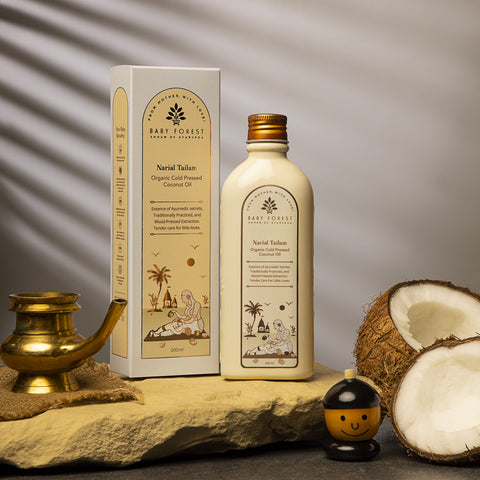
Choosing Organic Baby-Friendly Products
Opting for organic baby products can make a significant difference in preventing and managing cradle caps. Look for shampoos and skincare items with natural ingredients, free from harsh chemicals that could potentially worsen the condition.
When to Consult a pediatrician
While cradle caps are generally harmless, consult your pediatrician if you notice persistent redness or inflammation or if the condition spreads beyond the scalp. In rare cases, a prescription medication may be recommended.
A cradle cap may be a temporary visitor on your baby's scalp, but understanding its causes and treatment options can empower you as a parent. Embrace a gentle and organic approach to your baby's skincare routine, promoting a healthy scalp from the start. By incorporating these proactive measures, you can ensure that the cradle cap becomes just a fleeting moment in your parenting journey, leaving you with a happy and content baby.

Baby Loi Ubtan: Traditional & Modern Care for Stylish Moms
We all have at least one dainty memory of our Dadi maa or Nani maa rubbing the back of an infant with wheat atta loi, especially on a baby's forehead. Since babies are as delicate as rose petals, removing the excess baby hair by loi is pain-free. For these fragile and initial days, using wheat atta lLoi for babies is a perfect Indian tradition with an optimum amount of tenderness! Not as typical as it sounds, a loi is just a tiny amount of wheat dough rolled into a ball and dipped into oil of preference for giving a loi massage to your little one.
The Tradition of Loi in India
The tradition of rubbing a loi has its roots in the ancient heritage of baby care. You must have heard those tales about strong babies with strong muscles during childhood. Well, the seeds of that strength are sowed right in the newborn's first month. The soft massage allows them to handle the force provided by human hands in the next few months. The primary function of this practice is the removal of excess baby hair. But it has several other benefits. The soft atta lLoi takes care of the blood circulation in the most delicate way possible, reducing body hair growth. Along with it, it protects the baby from various toxins as well.
Types of Loi
Just like how every grandma and maa has her own best ways for their babies, the custom of lLoi is also different in every household. Some mothers use oils like sesame, mustard, and coconut oil to dip the dough. In contrast, others believe in adding a pinch of turmeric for protection. The goodness of these ingredients and natural plant extracts is what curates Baby Forest's Baby Loi Ubtan. We bring the concept of Loi and the nourishment of ubtan together in this magical box. Our ayurvedic composition of five ayurvedic plant extracts like wheat, turmeric, besan, licorice powder, and vetiver provides babies with tender care and saves their mothers some time.

Why should you choose Baby Forest's Loi Ubtan?
This Loi Uubtan is unique in its ingredients, texture, and fragrance. Starting with wheat flour, it helps to remove extra hair and acts as an antioxidant and cleanser. Turmeric does its wonder by improving the skin texture of the baby. From the forest of flour, gram flour enhances the skin's softness. At the same time, licorice and vetiver help as a natural coolant and prevent inflammation with their neutral oils. The powdered texture makes it handy and easier to use. You don't have to miss your baby's massage while traveling. The most distinctive advantage of the product is that you can pair it with our Gulaab Oose. The richness of traditional paatalam pushpah cohered with the mishran of vetiver creates a mystical fragrance that is both safe and soothing for the baby and the mother.

Step-By-Step Guide for The Proper Use of Baby Loi Ubtan

Step 1- Take two big spoons of Somya Nikhaar Baby Loi ubtan.

Step 2- Mix the ubtan with the desired quantity of Baby Forest rosewater and purified water.
![]()
Step 3- Create a thick paste and knead soft dough for the baby.

Step 4- Rub that loi in a circular motion on the baby's back, forehead, legs, and arms.
Note: Rub a Loi after giving an oil massage to your baby.
Modern moms need a vogue product for their young ones while keeping the traditional treasure intact. Baby Loi ubtan is a balanced bridge between tradition and urban parenthood.

The Ultimate Guide to Baby Face Creams
Welcome to the incredible journey of parenthood, where each choice seems to hold immense significance for your precious little one. Among the pivotal decisions occupying your thoughts is the selection of the best products for your baby's well-being. Whether it's skincare or essential feeding items, as parents, you're constantly seeking the best options. However, when it comes to your baby's adorable face, have you ever considered why a regular cream might not suffice? It's a common question among parents: 'Can't we just use the same lotion we apply to their tiny toes?' The answer lies in the unique needs of your baby's facial skin. It requires a specifically formulated cream, as gentle and tender as their delicate skin demands.
The Need for Baby Face Cream
Your baby's facial skin is much thinner and more delicate than the skin on the rest of their body, akin to a soft canvas deserving of a gentle touch. Acting as a protective barrier, a good baby face cream shields their sensitive skin from harsh environmental factors. Due to the heightened sensitivity, baby faces are more susceptible to dryness and irritation. This is where a specially formulated face cream for babies comes in, helping maintain the natural moisture balance and preventing any discomfort. Unlike conventional lotions that may contain chemicals unsuitable for your baby's delicate skin, opting for a baby face cream with natural ingredients ensures you steer clear of potential irritants and allergens.
The Concerns About Chemicals in Baby Products
Traditional baby face creams often come with a side of synthetic fragrances and preservatives – not exactly what we want for our little one's delicate skin. Chemicals can be troublemakers, causing irritation or allergies. And trust us, baby skin deserves better. They can spark irritation or trigger allergies, turning a seemingly harmless skincare routine into an uncomfortable experience for your little bundle of joy. So, when it comes to choosing a baby face cream, veering away from these potential troublemakers is key.
Opting for baby face creams with natural ingredients is a conscious choice to ensure the well-being of your little one. Look for creams enriched with ingredients like shea butter, almond oil, coconut oil, mulethi, and cocoa butter. These botanical wonders not only moisturize but also possess soothing and anti-inflammatory properties, catering to the unique needs of a baby's skin.
Benefits of Natural Baby Face Cream
Using natural baby face creams isn't just a trend; it's a conscious choice for your baby's well-being. No harmful stuff, just pure, gentle care that leaves your baby's face feeling like a soft cloud. Organic ingredients work in harmony, ensuring your little one's skin stays healthy, happy, and radiant. The benefits of using natural baby face cream include providing gentle care for sensitive skin, ensuring freedom from harsh chemicals, offering anti-inflammatory properties, reducing the risk of allergies, ensuring safe everyday use, and supporting environmental friendliness.
How to Choose the Right Natural Baby Face Cream
Choosing the best organic baby face creams can be overwhelming, given the plethora of options available. But to make an informed choice, you can consider factors such as the product's ingredient list, certifications, and reputation of the brand. Look for products labelled as organic, hypoallergenic, and free from harmful additives. Read reviews or articles online to get valuable insights into the effectiveness of a particular cream. Baby Forest’s Khilta Mukhra Baby Face Cream is a luxuriously crafted cream made with Shea Butter, Kesar (Saffron), and Almond Oil that profoundly nourishes and hydrates the baby’s face while balancing and nurturing the baby’s complexion and texture.
How and When to Use a Baby Face Cream
During winter, when the air is dry and cold, it becomes even more crucial to moisturize your baby's face with the baby face cream for winter. Gently cleanse the face with a mild baby soap or cleanser, pat it dry, and then apply a small amount of the natural face cream. A pea-sized quantity is usually sufficient, and remember to focus on areas prone to dryness, such as the cheeks and forehead.
Consistency is key when it comes to skincare. Incorporate the use of baby face cream into your daily routine, preferably after bath time or before bedtime. The gentle massage involved in the application not only promotes circulation but also adds an extra layer of comfort for your little one.
Mastering the vast array of baby face creams is more than simply making a purchase; it's a thoughtful journey towards giving the greatest care to your child. Armed with the knowledge of the unique needs of your baby's delicate facial skin, you're better equipped to make informed choices. Whether you opt for a natural baby face cream to soothe and protect or prioritize gentle ingredients for your baby's well-being, the essence lies in understanding and catering to their individual requirements. As parents, we share the collective goal of nurturing our babies with the utmost care. As you start this parenting adventure armed with insights, may your choices be guided by the simple hope of seeing your little one's face glow with health, joy, and the genuine warmth of a parent's loving touch.



